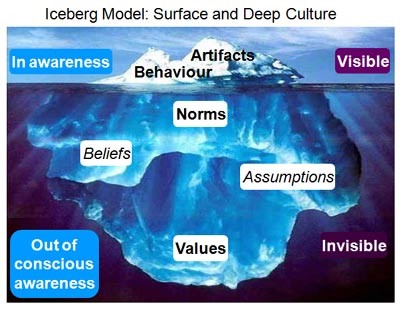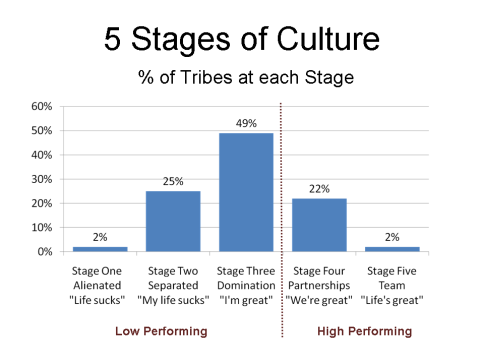Organisational Company Culture Change
Company / Team Culture Background
Organisational Culture: ”The way things get done around here.”
Or a more formal version (Schein) Organizational culture: “A pattern of shared basic assumptions that a group has learned as it solved its problems of external adaptation and internal integration, that has worked well enough to be considered valid and therefore, to be taught to new members as the correct way to perceive, think, and feel in relation to those problems.”
All business leaders need to know about “Organisational Culture” because it’s a primary influencer and/or hindrance that directly impacts mindsets, actions, and performance, AND RESULTS.
In a team or organisation Culture accounts for up to 50%+ variance in results. That’s a HUGE influence that most managers and leaders struggle with!


Tribal Culture Prevails in VUCA Times
Organisational Culture and the TRIBE’s identity is often times BIGGER than the leader. So many leaders are aware of something that seems to hinder or enable their effectiveness.
But they just aren’t sure on how to wrestle with this intangible, powerful force that pervades every corner of their work domain.
Like a swimming pools’ PH… Acidic or alkaline.
NOTE: Organisational Culture is not a Foundation or CORE cause in the beginning…
Culture becomes a CONSEQUENCE of numerous factors like People, teams and leadership. But CULTURE does become a cause in the feedback loop of the workplace and environment.
- Experience
- Meaning making
- Reaction
- Impacts
- Feedback
- Decision
ure is Hierarchical, Visible, and Invisible…
There are differing components of Organisational Culture to be aware of. Each level is DEPENDENT upon the lower level – Like a stair-step hierarchy.
- Level 1 : Behavioral (Visible): Culture can be seen in behaviors and external signs… or artifacts and rituals.
- Level 2: Psychological: (Somewhat Visible) Values, Beliefs, Attitude …Knowledge
- Level 3: Philosophical: (Less Visible) Like mindsets, Approach to issues, What’s NB
- Level 4: Invisible: Reactions, Time sort, Meta Programs, Meaning Making, Talents
- Level 5 – COMPLETELY hidden – Worldview: Motivations, Drives, Self-Perception, Self- Identity and Purpose.
Culture is a REACTION to 2 core components;
1. External forces / influences and
2. Internal rewards, inputs memories, meaning, reactions, responses and needs.
If you are going to impact your organisational culture in a positive and sustainable manner – you need to dig deep into the core… fully engage the participants in reengineering IDENTITY, MEANING, CONNECTION and Actioning Achievement.
You cannot directly change “Culture”. You have to change what causes and creates the “Culture” – There are 5 scientifically validated areas that are of most value to building a High Performance Organisational (HPO) & Culture.

## Understanding High-Performance Teams
High-performance teams are crucial for organizations aiming to thrive in today’s dynamic and often unpredictable business environment.
The concept of high-performance teams is deeply intertwined with organizational culture, which encompasses the values, beliefs, and behaviors that shape how work gets done within a company.
We explore the essential elements of high-performance team culture, actionable steps for fostering such an environment, and the benefits that arise from these efforts.
High-performance teams are characterized by:
– **Clear Goals**: Members understand the team’s objectives and how their roles contribute to achieving them.
– **Strong Communication**: Open lines of communication foster trust and collaboration among team members.
– **Shared Accountability**: Team members hold each other accountable for their contributions and outcomes.
– **Diverse Skill Sets**: A mix of skills and perspectives enhances creativity and problem-solving.
## The Role of Organizational Culture
Organizational culture serves as the foundation for building high-performance teams. It influences how team members interact, make decisions, and approach challenges. A positive culture encourages:
– **Engagement**: Employees feel valued and motivated to contribute.
– **Innovation**: A culture that embraces risk-taking and learning from failure fosters creativity.
– **Adaptability**: Teams are better equipped to navigate change when they share a supportive culture.
## Key Elements of High-Performance Team Culture
1. **Trust and Respect**: Building trust is essential. Teams should engage in activities that promote understanding and respect among members.
2. **Recognition and Appreciation**: Regularly acknowledging individual and team contributions boosts morale and encourages continued effort.
3. **Continuous Learning**: Encouraging ongoing development through training and feedback helps teams adapt and grow.
4. **Psychological Safety**: Creating an environment where team members feel safe to express their ideas and concerns without fear of retribution is vital for innovation.
5. **Alignment of Values**: Ensuring that the team’s values align with the organization’s mission fosters a sense of belonging and purpose.
## Action Steps to Foster High-Performance Team Culture
To cultivate a high-performance culture, organizations can implement the following strategies:
– **Conduct Team Assessments**: Regularly evaluate team dynamics and performance to identify areas for improvement.
– **Facilitate HPO Team-Building Activities**: Engage in structured team-building exercises that focus on collaboration, trust, Connection, cohesion and communication.
– **Implement Robust Honest Feedback Mechanisms**: Create channels for constructive feedback and blind-spot coaching to encourage open dialogue and continuous improvement.
– **Provide Professional Development**: Invest in training programs that enhance skills relevant to team objectives.
– **Celebrate Successes**: Recognize and celebrate both small and large achievements to reinforce positive behaviors.
## Benefits of High-Performance Team Culture
The advantages of fostering a high-performance team culture are substantial:
– **Increased Productivity**: Teams that work well together can achieve more in less time, leading to improved overall performance.
– **Enhanced Employee Engagement**: A positive culture boosts morale and reduces turnover, as employees feel more connected to their work.
– **Greater Innovation**: Teams that feel safe to share ideas are more likely to develop innovative solutions to challenges.
– **Improved Customer Satisfaction**: High-performing teams often deliver superior service, leading to increased customer loyalty and satisfaction.
– **Sustainable Growth**: Organizations that cultivate high-performance teams are better positioned to adapt to market changes and sustain long-term success.
## Conclusion
Building a high-performance team culture is not a one-time effort but a continuous process that requires commitment from all levels of the organization. By focusing on trust, communication, and shared values, companies can create an environment where teams thrive.
The benefits of such a HPO culture extend beyond individual teams, positively impacting the entire organization and its ability to navigate the complexities of the modern business landscape.
Incorporating these principles into daily operations can lead to a transformative shift in how teams function, ultimately driving success and fostering a http://www.revolutionaryworkplace.com culture where everyone can contribute to their fullest potential.
www.lifemasters.co.za for a REVOLUTIONARY WORKPLACE and High Performance Teams Culture Change Experience
v2025.1.7a
